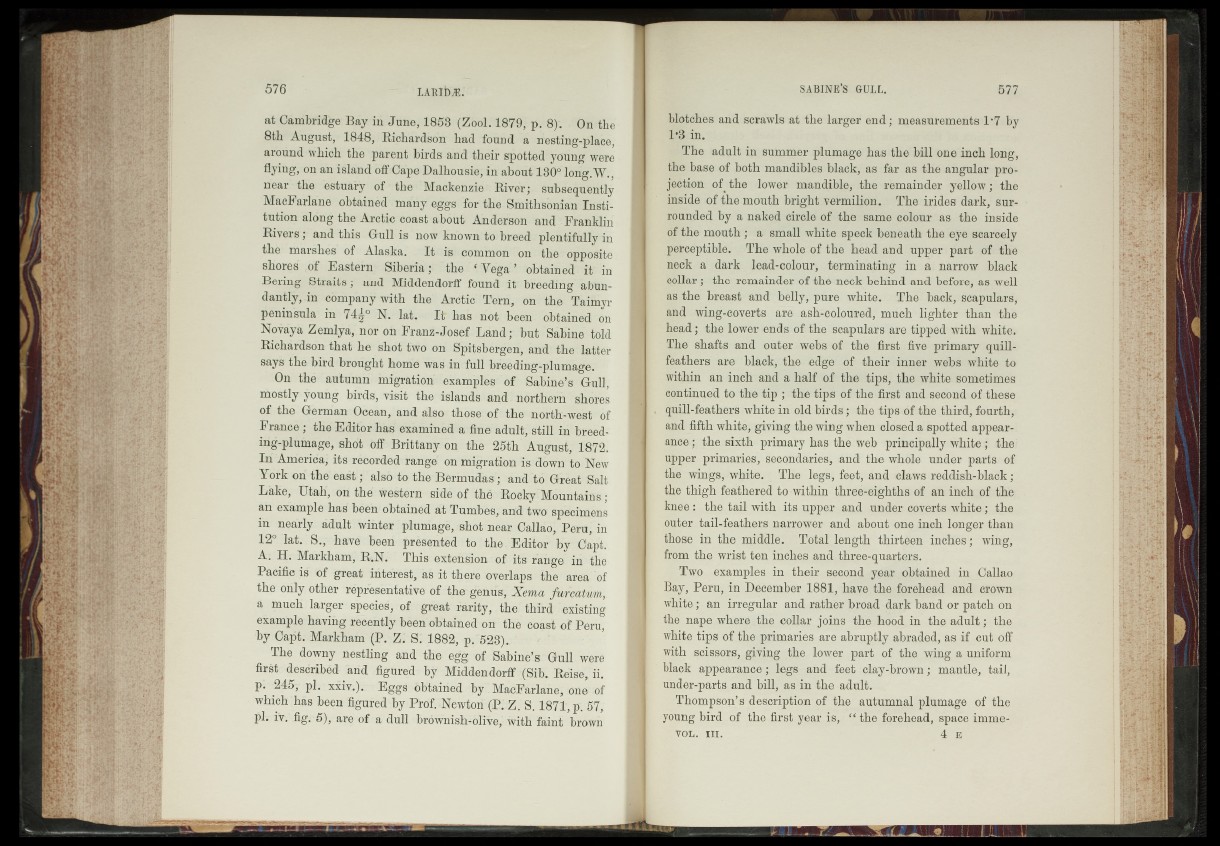
at Cambridge Bay in June, 1858 (Zbol. 1879, p. 8% Onrthe
8th' August, 1848, Richardson had found a nesting-place,
aroiind which the parent birds and their spotted'yo'üng were
flying, on an island offCape Dalhousie; in about lSIPiong.W.,
near the estuary o f1 the- Mackenzie j: RiveB; t subsequently
MacFarlane obtainéd many eggs "for the - Smithsonian' Institution
along the Arctic coast-abou-f Anderson and - Franklin
Rivers ; and this Gull is now known) to: breed plentifully^
thé marshes of Alaska. It is common^on-the* opposite
shores cof Eastern;' Siberia ;V: the ' ‘Yéga~’' "obtained‘fit' in
Bering Straits ; and Middendorff found it' breeding abundantly,
in company with the Arctic' Tern,* §h: the' Taifiiyr
peninsula in 7 4 ^ lb - la t.- Ifr ha's hot?/Beén^)btained on
Novaya Zemlya,.nor On Franz-Joséf Land; but SaB'ipë -told
Richardson that* he shot two on Spitsbergen, and"the: latter
says thé bird brought home was in full breedingiplumage.
On thé autumn migration-examples: of Sabine’s Gull,
mostly young birds, visit the islands and n o r t h e r n e r s
of the German'.Ocean, and also*; those^fsthes .-north:-west i óf
Fra-ncè ; thé Editor has" examined a fine; adult;.still.in-breed-
ing-pluinage, shot Off Brittany on the 21fih'August;'’18,72.
In America; its- récorded range" on migrafibn:usrdown"toi|fëw
York oh thé east-; also to the*Berinudas’; andt ó ’Great-Salt
LhKe, Utah, oh the western side of the" Rocky Mountaihsl;
an example has been obtained at Tümbés;and:two specimens
in nearly adult/winter plumage, shot hear Callao, Pe~M,r in
12° lat. S-.7 *have been prèsented to the| Editor-hy^^api.
A: IL Markham, R&N.’ This-oxtehsionK-nf'-its range ilt<tl’g
Pacific is- 'of great 'interest,'as it there overlaps the area of
the only, other 'representative of thergenusv
a much iarger’ speqiesj;^ great rarity, t the7 third;-è#S<ting
example having recently; beehobt-aihed?plf thé coast óf Peru,
by Gapt. Markham (P/Zi'S). 1882, p;'52S)jte
The downy nestling and the egg.-of Sabine’s:'Gull were
first described and figured?-by Middendorff Reisey n.
pi -2457 pi. - xxivv)^ Eggs ^obtained byr MacFarlane, one-rof
which 'has been figur ed'-by - Prof. ’< N e wtoh* (PbZ .1S. 1874', p'.MZ,.
ph I'V/fig.-%; are of a dull BrownisteMiveyiWitM faint brown
blotches and scrawls at the larger end; measurements P7 by
1*8 in.
- - The adult in summer plumage has the bill one inch long,
the base of both mandibles black, as far as the angular projection
of the lower mandible, dhe remainder yellow; the
inside of the mouth bright vermilion. The irides dark, surrounded
by a naked circle of the same colour as the inside
of the mouth ; a small white speck beneath the ©ye scarcely
perceptible. The whole of the head and upper part of the
neck a dark lead-colour, terminating in a narrow black
collar; the- remainder of 'the neck behind and before, as well
as-th/e breast and belly, pure white. The back, scapulars,
and wing-coverts are astocoloured,?:mdch lighter than the
head; the lower «ends of ithe scapulars are tipped with whiter
The shafts and outer webs of. the first-five primary quill-
feathers are black,Jthe, edge of their inner webs white to
within an inch and a half of the .tips, the white sometimes
continued to the tip ; the tips @0the first and.seeondof these
quill-feathers -white in old birds; the tipsóf 'the third, fourth,,
■ and fifth white, giving the wing when closed-a spotted appearance;
the sixth primary has-the web principally white j; ther
t Uipper primaries, secondaries, and the whole under parts of
\ the wings, white. 8 The- Legs; feet,-and claws reddigh-biadk;
the thigh feathered to-within three^eighihs of an inch of thie
knee :^th^«t§il; wijth .its upper and under co^erts-wfiite; the
■ outer ^ail-feathers narrower and about one inch longer than
I tïtose in the middle. Total .length thirteen infi^S§ wing,
F uqm the wrist tpn inches agd three-quarters.
'p,, Two examples in their- second year obtained an Callao
]|ay, Peril,- in December 188!yhave the forehead and erown
| white; an irregular and rather broad dark band or patch on
I the nape where ;th.e collar joins the hoodjn^ the adult-jf ,-th.e, ^
I wjpe tips of tbéprimaries are abruptly abraded, ag if cut off
I with scissors, giving t^e lower part of the wing a uniform
I black appearance;'-.legs and fejet clay-brown; mantle,- tail,
I under-parts, and bill, as in the adult.«»,.
Thompsons descriptiqucf' the ^ autumnal, plumage of the
I young bird .of the first year is,,* “ the forehead, space imme-
VOL. III. 4 E